

Disney's Story Of The Animated Drawing
Being but twenty-one months old at the time, I missed a landmark night in animation history. For we who came to know television first in the late fifties, it was perhaps less of a big deal than for those who remembered first sets being brought into homes. How special was Disneyland? Unless you were there, you’ll never know. Two of my friends were. One was nine when Walt Disney presented The Story Of The Animated Drawing on November 30, 1955. The other was only five. Both recalled details of a program they’d not seen in fifty-two years. We got out the DVD and watched, mostly to test their decades old recollection against long unavailable evidence now before us. How good is it? Well, imagine a history of cartooning seen through the eyes of many of its pioneers, hosted and narrated by the dean of them all. Disney spent what was needed to get such projects right, never mind that his venue was budget-conscious early television still shunned by other major studios. The Story Of The Animated Drawing remains the most polished and persuasive of any such documentary, and makes latter-day talking head-fests plod by comparison. If only we still had Walt to guide us through a now century of pictures that move! It’s hard to believe history so carefully and accurately explained was once marketed to a TV audience of millions. Disney flatters us still for assuming we’ve brains enough to sit for intelligent exploration of how cartoons got their start. I’ll bet the list of ignitions fired among future historians and animators on 11/30/55 would be a yard long, one of those rare hours of TV that ended with Junior knowing exactly what he wanted to do once he grew up.

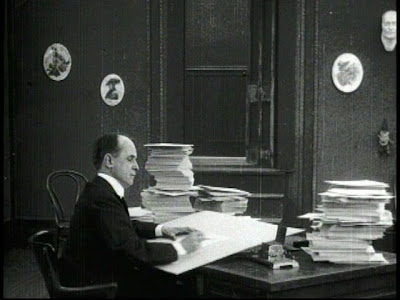
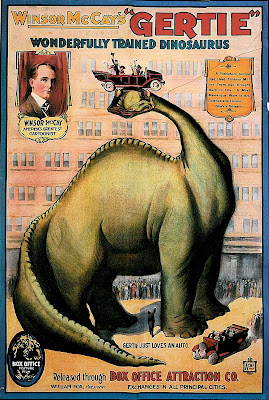
Hang it all for Disney having shot The Story Of The Animated Drawing in black-and-white! That alone put the episode in deep storage until only a few years ago when their DVD Treasures series unearthed it finally for inclusion in the Behind The Scenes At Walt Disney Studio two-disc set. Disneyland was an ABC program. For an industry in which the network ranked an always distant third, that was as good as being invisible, but Walt Disney on the schedule as of 1954 put an ABC series in the top-ten for the first time ever. Affiliates primarily committed to the network were few compared with leaders CBS and NBC. We only had Channel 13 out of Asheville, NC, and that was a hundred miles off. They ran Disneyland in its regular Wednesday night 7:30 berth. Stronger stations used ABC as secondary provider with delayed broadcasts of better shows the network offered. Disneyland played many markets on that basis. Charlotte’s Channel 3 presented it on Sunday afternoons, their prime-time schedule being taken up with CBS programming. Kids chased Disney along weekend grids that changed with sports seasons. They could never be certain just when their favorite hour would turn up. ABC was powerless to impose corporate will upon stations not their affiliates. It was accomplishment enough getting any of their product into these CBS/NBC dominated markets. Disney played close to the vest with content he owned and merely leased to ABC for what were often single runs. The Story Of The Animated Drawing disappeared after that second season of Disneyland. When the series went over to NBC with the addition of color in 1961, practical use for episodes originally filmed in black-and-white was nil. Syndication was out as that reduced control Disney insisted upon. Random episodes of Disneyland used to show up among collectors in 16mm, but these were exceedingly rare. You had to depend on anecdotal accounts as to what such old shows were like, as there seemed little chance of actually seeing them.
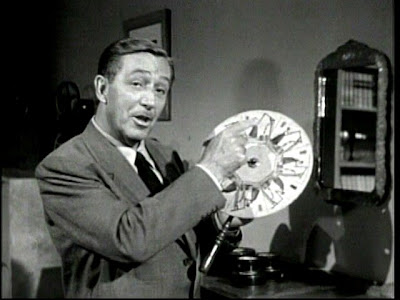
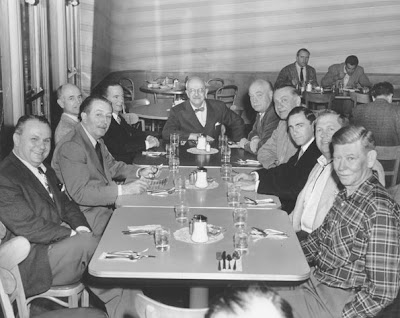
There should be dancing in the streets whenever another Disney Treasures DVD comes along. Stuff out of those vaults are filled with revelation. Perhaps best remembered of segments in The Story Of The Animated Drawing is a recreation of Winsor McCay’s 1914 vaudeville turn in which he introduced Gertie The Dinosaur. Even those minimally conversant on cartooning know Gertie, if not McCay (seen here drawing at his desk). My first exposure was in Richard Griffith and Arthur Knight’s 1956 book The Movies, which for a long time was about the only oversized and heavily illustrated volume you could get on the subject. I began wearing out my copy from the age of twelve (it remained in print through the sixties) and Gertie in particular appealed to me (that relevant page portion from The Movies shown here). I didn’t know until recently of her beginnings as animated adjunct to McCay’s live act. The Story Of The Animated Drawing gives us the latter verbatim as to its original stage script, the restaging having been supervised by McCay’s son, who’d been there when his father appeared before live audiences. This, to my mind, is the only way to watch Gertie The Dinosaur. A host of future animators were said to have made career decisions as a result of seeing Winsor McCay perform with his animated creation. The Fleischers, Paul Terry, Otto Messmer, Walter Lantz and others were among those converted. Gertie The Dinosaur would be released as a theatrical short subject later in 1914, padded with extraneous live action and titles standing in for McCay’s onstage interplay with Gertie. This is the version we’ve had since, though it would seem to me that Disneyland’s restaging is by far the more authentic record of how early audiences best experienced Gertie. As for Winsor McCay, 11/30/55 represented the largest single viewership his work would have before or since. Writers noted the artist’s obscurity from his death in 1934 until rediscovery in the sixties via a Canadian retrospect, but surely The Story Of The Animated Drawing, with its exposure to nearly forty percent of the nation’s twenty-six million TV households, represents the highpoint of a general public’s awareness of Winsor McCay. Who but Disney could have made it possible for so many to see McCay’s work again, and on network television yet --- such a thing won’t likely happen again in this lifetime. No matter the success of DVD sales and festival attendance, none could deliver beyond a fraction of the mass audience watching Gertie that night in 1955.
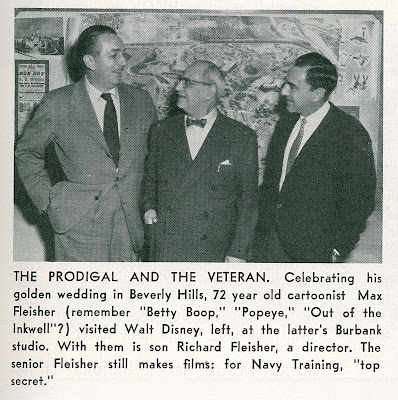
The Story Of The Animated Drawing was really Walt Disney’s outreach to pioneers living and dead. Perhaps mellowed after years of grim competition kept him at odds with rivals like Max Fleischer, Walt now assumed the role of gracious winner and paid tribute to men who’d made much of his success possible. Some not mentioned were drawing paychecks right on the Disney lot. Ub Iwerks received an end credit for visual effects on The Story Of The Animated Drawing, but his almost single-handed animating of excerpted Steamboat Willie and The Skeleton Dance many years before went unrecognized. Disney’s was on the one hand a generous gesture as well as opportunity to contrast primitive efforts of early animators with strides his studio had made since (here he displays one of many artifacts featured on the show). Fantasia was offered as culmination of the studio's achievement, and scenes from it comprised the final third of Walt’s presentation (was he paving publicity’s way for a reissue? --- if so, it was premature, as Fantasia would not return to theatres until July of the following year). Filling weekday hours of The Mickey Mouse Club, which had premiered on October 3, 1955, obliged Disney to resurrect some less polished efforts of his own. Early Mickeys and Silly Symphonies played on the kid-oriented show and would subsequently vanish from airwaves as surely as The Story Of The Animated Drawing, these including The China Plate (shown 11-9-55), Playful Pan (11-18-55), and a 1930 cartoon, Winter, featured on the Mouse Club two days ahead of the Disneyland episode of 11-30. (Very) old cartoons had, in fact, been all over television for several years prior to Walt’s homage. Programmers scrambled for what they could get during that bleak period before major studios made backlogs available. Paramount was, in fact, negotiating sale of their shorts, including many produced by Max Fleischer, just as one of his Out Of The Inkwell cartoons, The Tantalizing Fly, was serving as example (with onscreen Oliver Wallace as old time movie organist) of animation long past (and here’s the stinger to Disney’s tribute --- Fleischer’s name is misspelled in its titles!). The Tantalizing Fly was probably familiar to some watching The Story Of The Animated Drawing that night, for it and other silent Out Of The Inkwell shorts had run on many local stations since the late forties. Fleischer’s appearance on Disneyland, even if footage of him dated back thirty years, might have led to an invitation Walt extended a few weeks later. Max would be guest of honor at a January 4, 1956 studio luncheon (above) at which he was reunited with artists, now Disney employees, who’d once been his employees. Trade press coverage oddly referred to The Prodigal and The Veteran (as shown here), leading many to wonder, no doubt, which was who.
Three great books with everything you need to know on the foregoing subjects:
The Animated Man --- Michael Barrier's definitive biography of Walt Disney.
Winsor McCay: His Life and Art --- by John Canemaker and Maurice Sendak.
The Fleischer Story --- by Leslie Cabarga.
7 Comments:
Great posting!
Richard Fleischer told the story that when asked to direct 20,000 Leagues Under the Sea, he told Walt he'd have to call to the East Coast to check if this was ok with his dad. Max then said it was fine with him and to tell Walt he approved of his choice in directors.
To me it is especially great to see the luncheon photo in the Disney Studio's Coral Room that used to be on the side of the commissary next to the patio, with (clockwise) Gerry Geronimi, Walt, Ben Sharpsteen, Ted Sears, Max Fleischer, Dick Huemer, someone whose name eludes me right now, Richard Fleischer, Andy Engman and Wilfred "Jaxon" Jackson. Note at the table in the back producer Bill Anderson and later president Card Walker munching on their lunch...
Thanks for commenting, Hans --- Just checked out your own amazing animation website! Really liked all the info and rare images...
http://afilmla.blogspot.com/
I remember as a kid in the 80s the Disney Channel used to show cartoons from the "Fabulous Fleischer Folio." I'm not sure what series they ran in, perhaps "Donald Duck Presents," "Good Morning, Mickey" or randomly to fill the gaps between programs (as the Disney Channel did not run commercial breaks until the late 90s).
I was always intrigued by what the on-screen titles described as classic cartoons from a pioneer in the field. As I got a little older, I wondered why Disney was showing these cartoons and how they had come to "own" them (they probably didn't; many of the cartoons may have been in the public domain in the 80s, per the complicated ownership history detailed on the Fleischer Studios Wikipedia page).
Now that I've learned more about the history of animation pre-1950, it's interesting to see the Disney company paying tribute to a competitor in the Disneyland series and then some 30 years later on The Disney Channel station.
Another great post, John. Your mention of The Animated Man by Michael Barrier came as news to me, and a surprise. I had pretty much assumed that the definitive Disney biography was Neal Gabler's Walt Disney: The Triumph of the American Imagination, but checking out the Barrier book's sample pages on Amazon has persuaded me to pick it up; Gabler may have to share the honors after all. And you're certainly right about John Canemaker's book on Winsor McCay -- one of the essential works.
Wonderful post John. I was working on a review of Popeye Vol. 2 for The Shelf, and had to take a break to rewatch the Story of the Animated Drawing after reading this! Having just watched the Out of the Inkwell doc on the Popeye disc, they dovetailed very nicely. Thanks for a wonderful look back, as always, at happier days- and essential Americana and history.
Jim:
Re: Michael Barrier's bio of Disney-
Be sure to check out Barrier's own website in regards to his book and Gabler's book: http://www.michaelbarrier.com/Commentary/Gabler/GablerErrata.htm
It's interesting to compare the two. Having read Gabler's book and most recently Michaelis' book on Charles Schulz, it's seems that this more neo-biography than biography.
As a child, my dream was to be an animator and work for Walt Disney. Close friend of my grandfather's was a man named Joe Dubin (wonderful guy) who was a composer and arranger at Disney ("20,000 Leagues" and others) Joe was also the brother of Al Dubin, whom I never got to know -- he had passed-away some years before. Anyway, thru Joe's kindness, I was given a "tour" of the studio as a wide-eyed child, and that is a very special memory! (Many-years later I came back briefly to do some "voice-overs" for their Saturday Morning cartoons, which was fascinating. "Are you familiar with these shows?" they asked. "Sir, I know your Mickey Mouse and Donald Duck, and that's about it", I replied.) R.J.
Post a Comment
<< Home